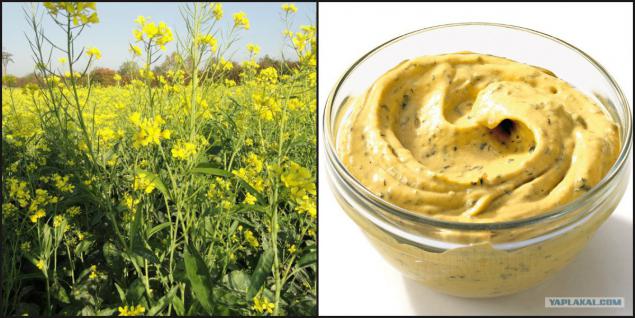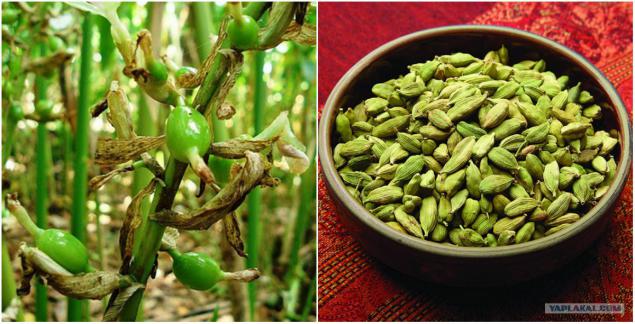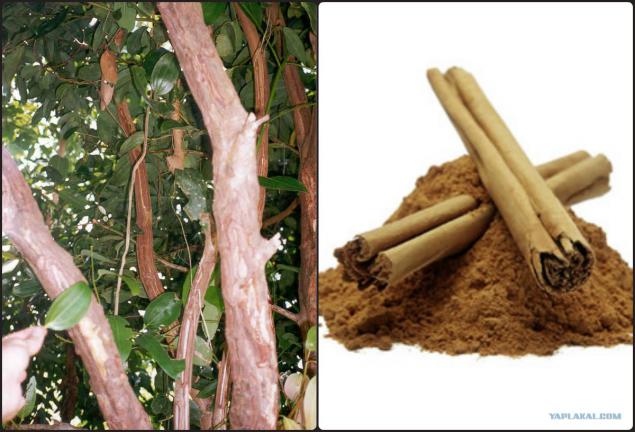740
How to grow spices
All of us in varying degrees we use in cooking spices but few people know how to grow those or other seasonings. Here you can find just some of the natural spices, the most popular.
1) Black pepper. The fruit grows on a vine, a plant native to India, but today it has grown in many tropical countries. The main exporters - Indonesia. Ripening fruit peppers are green at first, then red, yellow or dark brown. Familiar to us seasoning - is the dried unripe fruits rich in vitamin C.

2) Allspice (also called English or Jamaican). It grows on a tree height of 10 meters. Homeland allspice - Central America, but today it is grown in India and Indonesia. In the immature state of the fruits of this tree have a blue-green color, but after they turn brown and dry up sold as a condiment. Allspice has antiseptic properties.

3) Mustard. The seasoning is made from whole or ground seeds of the plant with the same name. When producing the familiar pastes except mustard use more water, vinegar, sugar, and other ingredients. Homeland plants considered Asia. Mustard is credited with improving the properties of the digestive system, it also contains substances that break down fats.

4) Cloves - a dried flower buds of a tropical allspice. Homeland plants considered Indonesia, but today it is also grown in Tanzania (90% of world production), Sri Lanka, Malaysia, Madagascar, etc. Said seasoning has analgesic and diuretic.

5) Ginger today consume both pickled and in powder form. Man eats the rhizome of the plant. His birthplace - South Asia today is made in China, India, Indonesia, Australia, West Africa, etc. Interestingly, rhizome has anti-inflammatory properties to the oral cavity and improves metabolism.

6) Cardamom - seeds of herbaceous perennial plant of the ginger family. Seasonings they are after will dry them twice. Homeland cardamom - India and Sri Lanka, who still hold the leading position for the production of spices. The cardamom contains calcium, iron, magnesium and zinc, it has analgesic and antiseptic properties. In folk medicine used in the treatment of coughs and bronchitis, as well as normalization of digestion.

7) Cinnamon - the dried bark of the tree, which is used as a spice. Sometimes it is sold in a dried form of tubes, often - in the form of a hammer. Today the bush from which the cinnamon is cultivated in tropical countries, mainly in Sri Lanka. Cinnamon - a recognized antioxidant, also has antimicrobial properties, so it is often used as part of cold remedies.

8) Sesame (Sesame) - seeds of herbaceous plants of the same name, which grows wild in tropical and southern Africa. The seeds used for oil production, as well as in cooking. In the East, believe that the sesame seeds prolongs life, used in Ayurveda for skin diseases.

9) Vanilla - the fruit of many years of vines of the orchid family. Homeland vanilla - Mexico and Central America, the world leader in the production - Madagascar. The manufacturing process of vanilla is rather complicated, so I will not describe it. This is one of the most expensive spices in the world market, which led to the appearance of its artificial substitute - synthetic vanillin. This vanilla relieves tension and stress, has a stimulating properties.

Source:
1) Black pepper. The fruit grows on a vine, a plant native to India, but today it has grown in many tropical countries. The main exporters - Indonesia. Ripening fruit peppers are green at first, then red, yellow or dark brown. Familiar to us seasoning - is the dried unripe fruits rich in vitamin C.

2) Allspice (also called English or Jamaican). It grows on a tree height of 10 meters. Homeland allspice - Central America, but today it is grown in India and Indonesia. In the immature state of the fruits of this tree have a blue-green color, but after they turn brown and dry up sold as a condiment. Allspice has antiseptic properties.

3) Mustard. The seasoning is made from whole or ground seeds of the plant with the same name. When producing the familiar pastes except mustard use more water, vinegar, sugar, and other ingredients. Homeland plants considered Asia. Mustard is credited with improving the properties of the digestive system, it also contains substances that break down fats.

4) Cloves - a dried flower buds of a tropical allspice. Homeland plants considered Indonesia, but today it is also grown in Tanzania (90% of world production), Sri Lanka, Malaysia, Madagascar, etc. Said seasoning has analgesic and diuretic.

5) Ginger today consume both pickled and in powder form. Man eats the rhizome of the plant. His birthplace - South Asia today is made in China, India, Indonesia, Australia, West Africa, etc. Interestingly, rhizome has anti-inflammatory properties to the oral cavity and improves metabolism.

6) Cardamom - seeds of herbaceous perennial plant of the ginger family. Seasonings they are after will dry them twice. Homeland cardamom - India and Sri Lanka, who still hold the leading position for the production of spices. The cardamom contains calcium, iron, magnesium and zinc, it has analgesic and antiseptic properties. In folk medicine used in the treatment of coughs and bronchitis, as well as normalization of digestion.

7) Cinnamon - the dried bark of the tree, which is used as a spice. Sometimes it is sold in a dried form of tubes, often - in the form of a hammer. Today the bush from which the cinnamon is cultivated in tropical countries, mainly in Sri Lanka. Cinnamon - a recognized antioxidant, also has antimicrobial properties, so it is often used as part of cold remedies.

8) Sesame (Sesame) - seeds of herbaceous plants of the same name, which grows wild in tropical and southern Africa. The seeds used for oil production, as well as in cooking. In the East, believe that the sesame seeds prolongs life, used in Ayurveda for skin diseases.

9) Vanilla - the fruit of many years of vines of the orchid family. Homeland vanilla - Mexico and Central America, the world leader in the production - Madagascar. The manufacturing process of vanilla is rather complicated, so I will not describe it. This is one of the most expensive spices in the world market, which led to the appearance of its artificial substitute - synthetic vanillin. This vanilla relieves tension and stress, has a stimulating properties.

Source:
























